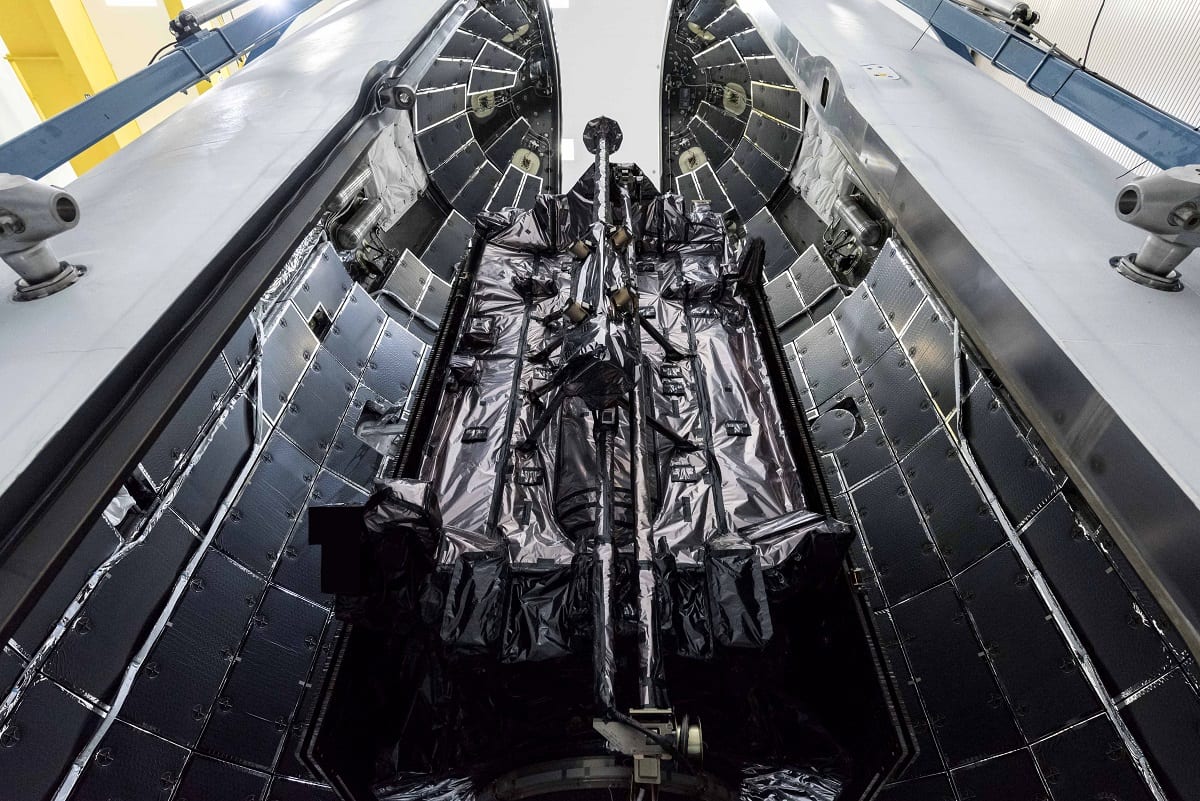
The fourth GPS III satellite is encapsulated within a SpaceX payload fairing on Sept. 21 in preparation for its launch from Cape Canaveral Air Force Station, Fla. Encapsulation of the satellite within the payload fairing protects the satellite from the impact of dynamic pressure and aerodynamic heating during its journey through the earth’s atmosphere, and supports the ability to communicate with the satellite until separation from the launch vehicle on-orbit. (U.S. Space Force Space and Missile Systems Center)
SpaceX is undertaking a system-wide review of Falcon 9 rocket to help ensure that the company can meet its goal of assured, more affordable access to space.
The review came after an unexpected pressure rise in the rocket’s turbo machinery gas generator scrubbed the scheduled launch of the fourth GPS III satellite on a SpaceX Falcon 9 rocket at 9:43 p.m. on Oct. 2nd from Cape Canaveral, Fla.
“We’re doing a broad review of launch site, propulsion, structures, avionics, range and regulatory constraints this weekend,” SpaceX founder Elon Musk said on Oct. 3. “I will also be at the Cape next week to review hardware in person.”
The Falcon 9 launch of the fourth GPS III satellite will be important for future National Security Space Launch (NSSL) in demonstrating reliability and cost reduction, as SpaceX is to re-use the rocket to launch the fifth GPS III satellite next year.
The launch will be the third NSSL mission on a Falcon 9 rocket, the second U.S. Space Force (USSF) first-stage booster recovery, and the sixth USSF launch, according to Space Force’s Space and Missile Systems Center at Los Angeles AFB, Calif.
Air Force Col. Cordell DeLaPena, program executive officer for SMC’s Space Production Corps, said in a statement that the GPS III satellites’ “nearly 70 percent digital payload provides the U. S. Space Force with greater operational flexibility and cutting edge capabilities while continuing to support legacy users.”
Lockheed Martin’s GPS III satellites have a 15-year design life, three years beyond the previous generation, and add new capabilities, including the L1C civilian signal, which is to allow interoperability with international satellite navigation systems, such as Europe’s Galileo. GPS III also provides three times greater accuracy and up to eight times improved anti-jamming power over satellites in the current constellation, Lockheed Martin said.
The fourth GPS III satellite “will be the 23rd M-Code enabled satellite in the [31 GPS satellite] constellation – just one short now of the 24 needed for global coverage, the company said. The military has sought M-code because of its security and anti-jamming capabilities.
Walter Lauderdale, mission director for SMC’s Launch Enterprise, said recently that contract negotiations for Falcon 9 reuse will save $52.7 million. SMC expects a delay in the fifth launch of GPS III from January to next summer to allow time for reuse validation activities. SMC’s Launch Enterprise has also agreed to reuse Falcon 9 boosters from that launch and the sixth GPS III launch.
The last two years have marked quite a turnaround for SpaceX in the military space launch market, and the company is now looking to give United Launch Alliance (ULA) – composed of Boeing and Lockheed Martin – a run for its money.
In August, ULA and SpaceX received $653 million in contracts for three classified launches – two for ULA and one for SpaceX under Phase 2 of the U.S. Air Force’s launch service procurement (LSP) for NSSL.
Under the Phase 2 terms, ULA may receive 20 future launches and SpaceX 14. ULA is under pressure to ensure its Vulcan rocket performs well and proves reusable in Phase 2 to reduce costs significantly below the $400 million per launch for Delta IV Heavy. ULA’s Delta IV Heavy is the sole remaining Delta rocket after the retirement of the Delta IV Medium last year and the Delta II in 2018.
As SpaceX searches for a new date for the launch of the fourth GPS III satellite on Falcon 9, ULA is looking for another date to launch a Delta IV Heavy rocket carrying the NROL-44 mission for the National Reconnaissance Office, what would be ULA’s 30th mission for the NRO. Due to a series of weather events and technical glitches, including a hot-fire, automated abort on Aug. 29, ULA has had to scrub the NROL-44 launch six times since Aug. 26.
ULA said on Oct. 1 that Delta IV Heavy “was chosen to perform NROL-44 because it is the only rocket that meets all requirements for this essential national security launch.”